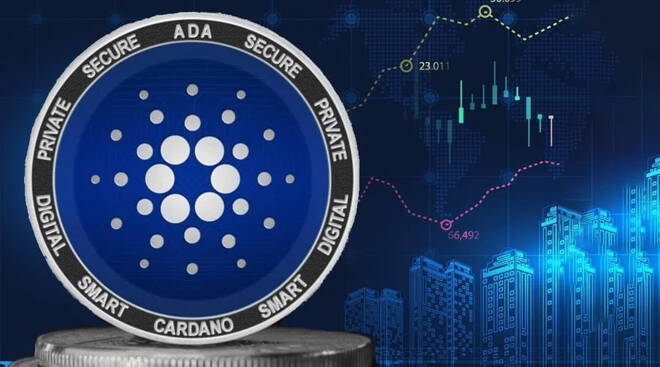Advertisement
Advertisement
Can Cardano (ADA) Outshine Solana (SOL) and Avalanche (AVAX)? Key Metrics to Watch
By:
Can Cardano (ADA) price catch up with Solana (SOL) and Avalanche (AVAX) as layer-1 coins lead the crypto market recovery?
Key Insights:
- Cardano (ADA) price jumped to $0.53 on Jan 30, marking a rapid 23% recovery from the 50-day low of $0.43 recorded on Tuesday, Jan 23, 2024.
- ADA recorded an 800% spike in Funding Rate on Jan 30, indicating that speculative traders are placing large bets on further gains.
- Historical accumulation trends show that the ADA price has now broken above a major resistance cluster at $0.54.
Cardano (ADA) price made a rapid 23% recovery to a 14-day peak of $0.54 after tumbling to the 50-day low of $0.43 on Tuesday, Jan 23. Derivatives market data shows that speculative traders are betting on more gains ahead.
Will Cardano price catch up with Solana (SOL) and Avalanche (AVAX) as layer-1 coins lead the crypto market recovery?
Layer-1 Altcoins, SOL, AVAX and ADA Leading the Crypto Market Recovery
Bitcoin ETFs finally recorded positive net-flows at the close of trading on Jan 24, marking the end of the dreaded sell-the-news cycle which saw the global crypto market capitalization shrink by more than 250 billion between Jan 11 and Jan 30.
As the crypto market entered rebound mode this week, mega cap Layer-1 coins, including Avalanche (AVAX), Solana (SOL), and Cardano (ADA) have emerged top weekly gainers in the top 20 crypto market rankings.
The chart below shows that, with 24.1% and 20.2% gains respectively, Avalanche and Solana have collectively added $14.95 billion in market capitalization. This leaves Cardano trailing with a slightly lower 16% price bump.
While Cardano’s 16.2% ($2.2 billion market cap) rally over the last seven days is nothing to scoff at, vital derivative market data trends observed on Jan 30 suggest that speculative traders are angling for a much bigger price breakout.
Cardano Recorded a 800% Spike in Funding Rate
Cardano, Solana and Avalanche have raced up the top gainers’ charts this week, adding billions of dollars in market capitalization. But looking beyond the spot market price charts, bullish derivatives traders appear to be placing unusually large bets on an imminent ADA price breakout.
Coinglass’s funding rates metric monitors real-time changes in fees paid by futures contract holders to opposing parties. This provides insights into overall sentiment among existing market participants.
Positive funding rates mean that LONG tradersare paying SHORT position holders to keep their contracts active, in anticipation that prices will increase and yield larger profits.
Interestingly, the chart above shows that, on Jan 30, Cardano funding rates rose 800% to hit 0.09% after having trended an average of 0.01% since Jan 2.
This ADA funding rate spike suggests that bullish speculative traders are paying record fees to keep their LONG positions open. Such a rapid increase in positive funding rate occurs when speculative traders spot a potential major bullish catalyst.
Given the dominant bullish momentum and billions of dollars flowing towards the layer-1 altcoin markets this week, this could mean that traders are betting big on ADA price potentially catching up to AVAX and SOL, both of which have delivered superior price performance in the last seven days.
Furthermore, the historical data trend also shows that ADA price has often made a leg-up whenever Cardano funding rate has recorded comparable spikes.
A repeat of the trend could propel ADA price up the charts in the days ahead.
Cardano Price Forecast: Will the $0.60 Resistance Cave?
Drawing inferences from the market data analyzed above, the current Cardano price uptrend could be attributed to bullish momentum surrounding the layer-1 altcoin markets. And the rising funding rates could further propel ADA prices.
The Parabolic Stop and Reverse (SAR) technical indicator also supports this bullish Cardano price forecast. When the Parabolic SAR dot points below an asset’s current price, it indicates an emerging bullish trend.
In this case, with the ADA Parabolic SAR dot pointing at $0.45 while ADA’s current is $0.51, it aligns with the bullish prediction.
Strategic traders may interpret this as a signal to go long in the derivatives markets or buy double-down on their spot positions, anticipating further Cardano price appreciation.
If this market scenario plays out as predicted, the bears can mount initial resistance at the $0.55 milestone price.
However, a major breakout above that area could set-off margin call triggers and short squeeze alerts, possibly sending ADA prices above $0.65 for the first time this year.
On the downside, the bears could invalidate this bullish Cardano price prediction if they can force a revesal below the $0.40 area.
However, as outlined by the Parabolic SAR dots above, the support buy-wall at $0.45 could pose a challenge. Once prices approach the $0.45 area, traders with highly-leveraged positions could make frantic purchases to avert major losses, and inadvertently trigger another price bounce.
About the Author
Ibrahim Ajibadeauthor
Ibrahim Ajibade Ademolawa is a seasoned research analyst with a background in Commercial Banking and Web3 startups, specializing in DeFi and TradFi analysis. He holds a B.A. in Economics and is pursuing an MSc in Blockchain.
Did you find this article useful?
Latest news and analysis
Advertisement
